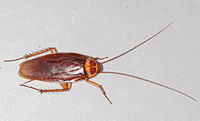有害生物

有害生物(Pest)泛指所有会对人类或人类日常生活关注的物种有害的动物或植物。这些人类关注的物种可能是禽畜业、农业或林业相关的物种。家居中会对人类造成滋扰的物种亦属于“有害生物”的范畴。而害虫这名词亦常用来指昆虫纲或其他虫状的有害生物。在比较古旧的文献,“有害生物”常指会引起致命流行病(特别是鼠疫)的生物。广义来说,所有会对人类造成竞争威胁的生物都可被列为“有害生物”[1][2]。
害虫是人类对一些节肢动物(大多属于昆虫纲)的定义,这些动物往往会对人类的生活、生产产生负面影响,即使有部分不会损害人体健康,都仍然会损害植物或人类管有的物资。
概念
任何生物:不论是动物、植物或真菌,但凡对人类本身、人类关注的动物或植物、畜牧业、人工构筑物等具入侵性或引起麻烦,均属于“有害生物”。
由于这个概念比较宽松,所以一个物种在一种环境会被认为是有害生物,在另一个较有利的环境,可能会被认为有益。这种现象在植物界或真菌界尤为常见。

对于动物,但凡会对农业造成损害的动物,不管牠们是以农作物为食,又或寄生在家畜,都是有害生物。例如:寄生在苹果上的苹果蠹蛾、又或棉花的棉铃象鼻虫。对于会对野外的生态系统造成破坏,又或会将细菌带进人类栖息地的物种,也符合有害生物的定义。会携带能引致人类疾病的例子包括有:会引致腺鼠疫的跳蚤及被这种跳蚤寄生的大鼠,会携带可引致疟疾病毒的疟蚊,还有会引致莱姆病的真蜱科物种。
一种物种在一种环境中可以是有害生物,但在另一种环境中却属于有益或可被驯化(例如,被引入澳大利亚的欧洲兔子导致生态损害超出了在牠们的自然栖息地造成的规模)。 许多杂草在某些条件下也被视为有用,例如车前叶蓝蓟通常被视为蜜蜂和野花的食物,即使它可以毒害牲畜。此外,一些动物虽然对人类有着直接的危害,但是它们对于当地的生态系统却又是不可或缺的一部分,甚至能间接造福人类,例如胡蜂虽然会伤害人类、攻击养蜂人的蜂箱,但是它同样也是许多害虫的天敌,还是重要的植物传粉者,甚至有许多植物是完全依靠胡蜂进行传粉的;苍蝇是重要的分解者和许多重要经济作物的主要传粉者之一;蛇和狼同样也是重要的掠食者,如果没有它们,许多食草动物和杂食动物(如兔、鼠)的种群都会不加节制的增长,造成当地生态系统的严重破坏。
有害动物若按其对经济所造成的损失来排序,以节肢动物所造成的损失最高,而节肢动物当中又以螨虫造成的损失最大;其次是线虫动物门及腹足纲物种[3][4]。
实例

- 卫生害虫
- 农业害虫
- 蚜虫
- 蚂蚁(部分)
- 蝗虫
- 蓟马
- 介壳虫
- 二斑叶螨
- 木虱(Psyllidae)
- 啮虫(Psocoptera)
- 叶蝉
- 褐飞虱(Nilaparvata lugens)
- 玉米螟(Ostrinia spp.)
- 斜纹夜蛾(Spodoptera litura)
- 小菜蛾(Plutella xylostella)
- 苹果蠹蛾(Cydia pomonella)
- 纹白蝶(Pieris rapae,仅幼体,成体为益虫。)
- 东方果实蝇(Bactocera dorsalis)
- 浮尘子(叶蝉,禾本科植物皆会受害,尤其是稻、麦、高粱,并传播黄萎病等传染病)
- 红蜘蛛 (害虫)(危害番木瓜)
- 白蚁
- 叶蜂(蔷薇科的叶子几乎都会受害,部分种类会造成“虫瘿”,使植物无法得到养分)
- 摇篮虫(危害葡萄科之叶)
- 象鼻虫(在植体上钻孔产卵)
- 金花虫科(危害叶子)
- 宅泥虫(同金花虫)
- 蝉/沫蝉(危害甘蔗等)
- 美国白灯蛾(为害樱、桑、栗、栎树叶,造成农损,亦是著名的“行道树大盗”。)
- 螟科
- 天牛(主要是葡萄藤天牛)
- 椿象
- 贮谷害虫
- 米象(Sitophilus oryzae)
- 豆象(同米象,以豆科为主)
- 蚁象(以甘薯为主)
- 拟榖盗(同米象)
- 森林害虫
- 天牛
- 松毛虫(Dendrolimus spp.)
- 舞毒蛾(Lymantria dispar)
- 白蚁
- 渔业害虫
不属于昆虫的有害生物
被人类破坏其生存环境而成的:
参看
参考文献
- ^ pest. Merriam-Webster dictionary. [2012-08-22]. (原始内容存档于2019-11-30).
- ^ Pest vermin. Britannica. [2016-08-24]. (原始内容存档于2015-04-26).
- ^ Speiser, Bernhard. Molluscicides. Pimentel, David (编). Encyclopedia of Pest Management (Print). CRC Press. 2002-05-09. ISBN 978-0-8247-0632-6. doi:10.1201/noe0824706326.ch219 (英语).[失效链接]
- ^ Stange, L. A. Snails and Slugs of Regulatory Significance to Florida March 2006. Division of Plant Industry, Florida Department of Agriculture and Consumer Services. 2006-03 [2010-08-27]. (原始内容存档于2010-12-02) (英语).
延伸阅读
- John B. Burch. 1960. Some snails and slugs of quarantine significance to the United States. U.S. Dept. Agriculture, Agricultural Research Service 82(1): 73 pp
- Hockings, F.D, 2014,"Pests, Diseases and Beneficials (页面存档备份,存于互联网档案馆)", CSIRO Publishing, Melbourne, ISBN 9781486300211
外部链接
| |||||||||||||||||
Text is available under the CC BY-SA 4.0 license; additional terms may apply.
Images, videos and audio are available under their respective licenses.
